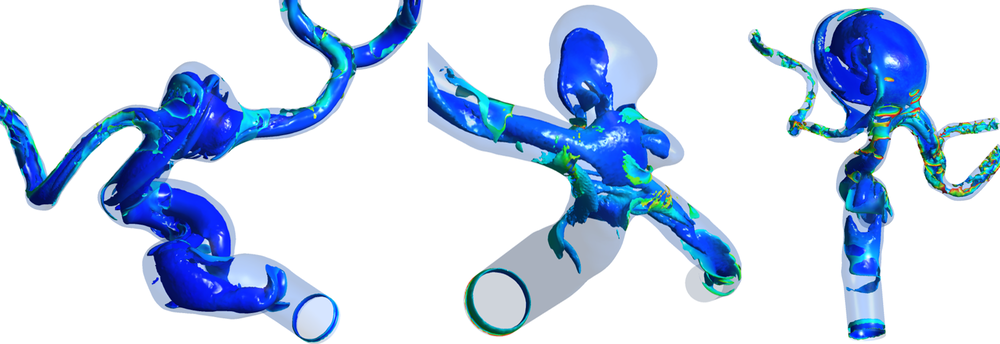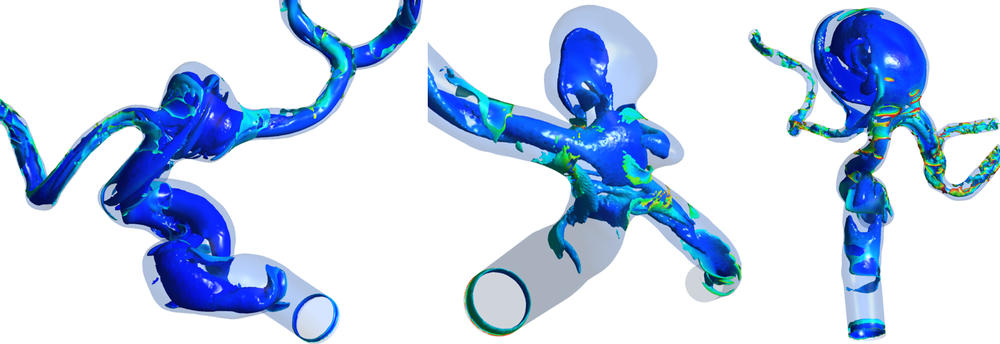Predicting Hemorrhagic Stroke
As blood flows through the body, it shapes the circulatory system. Understanding the influence of blood flow on arteries and veins is vital for the diagnosis and treatment of conditions such as aneurysms, which are bulges that can form in blood vessels. Now a team of neurosurgeons and engineers have experimentally and numerically looked at the role of blood flow in the bursting of a rare kind of aneurysm [1]. The results could help identify risk factors in patients living with the condition.
Aneurysms can develop when the wall of a blood vessel weakens. Though most brain aneurysms are benign, if such an aneurysm ruptures, the person can suffer a hemorrhagic stroke—a medical emergency that has a greater than 50% risk of death. Whether to surgically treat an aneurysm is typically determined by its size, with 7 mm being the generally accepted minimum diameter for treatment. However, aneurysms with diameters smaller than this threshold can still cause strokes.
Advances in medical imaging mean that it is possible to take in vivo 3D images of a brain aneurysm. Using such images, clinicians and scientists can numerically solve the equations of the motion of blood in the aneurysm and in the vessels attached to it. Scientists think that the solutions could be used to predict the likelihood that an aneurysm will rupture.
Although such predictions have yet to be made in a clinical environment, scientists have theoretically and experimentally identified that ruptured aneurysms are more likely to have had a pronounced balloon-like shape before they burst. But the interplay between the blood-flow patterns within an aneurysm, the shape of the aneurysm, and the risk of rupture remained unclear.
To resolve this problem, Mahesh Nagargoje of the Sree Chitra Tirunal Institute for Medical Sciences and Technology, India, and his colleagues recruited three patients with a rare and potentially high-risk internal carotid artery bifurcation aneurysm. This type of aneurysm forms between two branches of an artery and is difficult to treat with surgery without damaging the brain and the surrounding blood vessels.
The team imaged each aneurysm with digital subtraction angiography and measured the velocity of the blood in the connected vessels using Doppler ultrasound. Using this data, they modeled the flow of blood as it entered through the aneurysm’s neck, moved around its dome, and came back out.
For the aneurysm with the smallest neck-width-to-dome-radius ratio, the team found that the friction between the blood and the vessel wall induced a high shear stress in the walls of the neck and a low shear stress in the walls of the dome, where the model showed the blood stagnates. Both of these characteristics have previously been linked to aneurysms with a high risk of rupture. At points of high shear stress, they found that blood impinges on the aneurysm’s walls, which the researchers believe could make it easier for the aneurysm to grow. Low shear stress within the aneurysm allows adhesion of white blood cells to the inside of the bulge, which the researchers think could trigger an immune response that is known to cause vessel walls to weaken.
For the aneurysm with the most complex shape—a second aneurysm had grown out of the first, creating a bulge with a number eight shape—the team found in the first chamber chaotic blood flow, and in the second stagnation. The team hypothesizes that the stresses induced in the walls of the first chamber and the weakening of the walls in the second could explain the clinical observation that aneurysms with irregular shapes are more likely to rupture.
Jayanand Sudhir who worked with Nagargoje on the study, says that although the research is in its nascent stage, he and his colleagues think that they are “on the right track” to finding the parameters that determine rupture potential. Makoto Ohta, a medical engineer at Tohoku University, Japan, says that while he is personally very interested in using computational fluid dynamics models to predict aneurysm rupture, he thinks that much larger studies are needed before researchers can make any firm conclusions. Lorenzo Botti, a researcher in fluid mechanics at the University of Bergamo, Italy, adds similar caution to interpretations of these results. “Population studies are required to validate any hypothesis regarding the influence of hemodynamics on the pathology.”
The team plans to collect data on at least 200 other aneurysms, Sudhir says. If their initial findings hold, Sudhir thinks that clinicians could start using their model to identify and then treat aneurysms that have a high risk of bursting, reducing the mortality rate of the condition.
–Katherine Skipper
Katherine Skipper is a science writer based in Bristol, UK.
References
- M. S. Nagargoje et al., “Influence of morphological parameters on hemodynamics in internal carotid artery bifurcation aneurysms,” Phys. Fluids 34 (2022).





